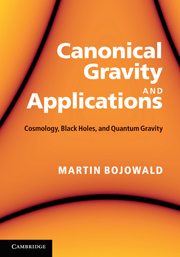3 - Hamiltonian formulation of general relativity
Published online by Cambridge University Press: 05 August 2012
Summary
As we will see throughout this book, Hamiltonian formulations provide important insights, especially for gauge theories such as general relativity with its underlying symmetry principle of general covariance. Canonical structures play a role for a general analysis of the systems of dynamical equations encountered in this setting, for the issue of observables, for the specific types of equation as they occur in cosmology or the physics of black holes, for a numerical investigation of solutions, and, last but not least, for diverse sets of issues forming the basis of quantum gravity.
Several different Hamiltonian formulations of general relativity exist. In his comprehensive analysis, Dirac (1969), based on Dirac (1958a) and Dirac (1958b) and in parallel with Anderson and Bergmann (1951), developed much of the general framework of constrained systems as they are realized for gauge theories. (Earlier versions of Hamiltonian equations for gravity were developed by Pirani and Schild (1950) and Pirani et al. (1953). In many of these papers, the canonical analysis is presented as a mere prelude to canonical quantization. It is now clear that quantum gravity entails much more, as indicated in Chapter 6, but also that a Hamiltonian formulation of gravity has its own merits for classical purposes.) The most widely used canonical formulation in metric variables is named after Arnowitt, Deser and Misner (Arnowitt et al. (1962)) who first undertook the lengthy derivations in coordinate-independent form.
Information
- Type
- Chapter
- Information
- Canonical Gravity and ApplicationsCosmology, Black Holes, and Quantum Gravity, pp. 17 - 112Publisher: Cambridge University PressPrint publication year: 2010
